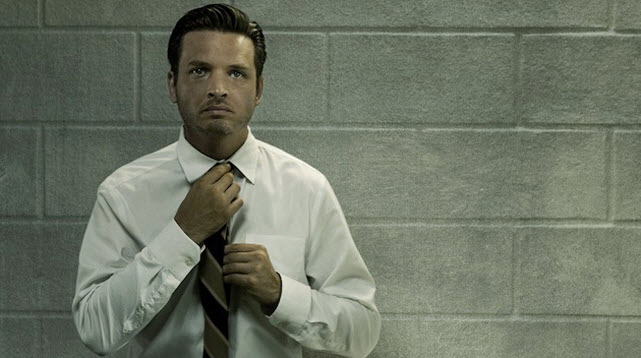
Whether or not you love Rectify will depend on what you expect and want out of television. In many ways, Ray McKinnon’s series about a former death row inmate who has been released plays more like independent cinema than a traditional show, fitting the SundanceTV brand perfectly (Top of the Lake, The Returned and The Red Road are similar compositions on certain levels). If that description turns you off, the slow pacing and spiritual inquiry of Rectify will probably bore you before it entertains you. If you’re reading a review of its second season premiere, though, you’re likely to have seen the first season already and know that Rectify joins only a handful of shows–Hannibal, Louie, Mad Men–as something so distinctly and obviously several cuts above 99% of television. It is, much more than those series, so terribly difficult to describe when making a case for why it is so special. Many people would point to its treatment of religion, which is smart and not the least bit condescending. Even for viewers who have a natural impulse to treat that kind of material with cynicism, there is no eye-rolling going on in Rectify. Other people might point to the other individual parts of the series that work so well: the haunting music, the remarkable performances (led by Aden Young in the main role of Daniel Holden), its ability to use the dual-narrative device effectively with constant flashbacks, etc. But these are all common things we might point to when describing a television series. Rectify‘s most amazing quality is how utterly unique it is within the medium. Anyone familiar with Mike White’s Enlightened will have some sense of what I mean by that, since that series was (is) similarly beautiful in how it eschewed typical categorization. Rectify is somewhat of a spiritual successor in that regard and reminds me during “Running with the Bull” that McKinnon is one of the finest storytellers in the business and has crafted one of the finest products available.
Season two picks up immediately after season one. Daniel is in a coma after being beaten. Sheriff Dagget is investigating the crime, putting him at odds with the townsfolk who still think that Daniel is guilty of the crime he was originally arrested for. Amantha, Daniel’s sister, is still not getting along with Ted Jr., her stepbrother. And the rift between Ted Jr. and Tawney is becoming more complicated in the wake of Daniel’s hospitalization. Not just limited to flashbacks on death row, the narrative also makes room for fantasies of Daniel’s that include Kerwin, the inmate who became Daniel’s only real friend and who died at the end of the first season. If I had any reservations about “Running with the Bull” as I was watching it, it was bringing back Kerwin like this (the first sequence of the episode features him). His scene with Daniel in the season one finale, in which he tells Daniel that he knows he didn’t commit the crime he’s serving time for (“Because I know you,” is his reasoning), was among the best individual moments of any episode of any TV series all last year–and coming from a die-hard Spartacus fan, that’s high praise. So, it made me worried that the moment and its impact would be lessened in retrospect by using Kerwin (played to perfection by Johnny Ray Gill) in season two. I’m clearly a moron, though, because this premiere’s strongest moment–one that made me weep (start keeping track, because I doubt this will be the only time this season)–is its final sequence, which is one of Daniel’s fantasies with Kerwin while he’s unconsciously aware he’s in a coma. Daniel doesn’t want to let Kerwin down, but what he doesn’t know is how much of a love of life Daniel gave to him. “You look at life like it’s a burden,” he tells Daniel at the beginning of the episode. “Life is a gift, man.” So, while it’s not Kerwin’s place to say whether Daniel should give up and loose his grip on life, Kerwin’s sheer happiness when he learns that Daniel got off the Row communicates to Daniel that Kerwin would want him to live. Daniel has only begun to experience the beauty around him–something that the first season of Rectify focused heavily on in long, contemplative moments. The best way to honor the memory of his friend is to keep on going.
As a disclaimer, one thing you probably won’t be reading in these reviews is much commentary/analysis of the plot in Rectify. It neither interests me nor is something I think Ray McKinnon wants us to be focusing our attention on. It is merely a framing device in this series and works perfectly fine in that role. So, while the scenes with the sheriff and Senator Foulkes are well-acted and give insight into those characters (at least the sheriff), they are means to an end. Outside of the Daniel material (and it’s amazing how much of a presence Young can be while his character is essentially immobile), the Ted Jr. scenes carry the most weight. This, for viewers of Rectify, is wonderfully surprising given that his character was somebody easy to dislike in season one. His scene with Tawney, however, is heartbreaking. She asks him to hold her, but he can barely maintain composure after being struck and scared by Daniel last season as a way of being shown what it’s like to go through what Daniel did. If this season pivots around Ted Jr. as a character undergoing change, I can’t imagine a more intelligent decision in terms of building story around Daniel while he’s incapacitated. Tawney and Amantha are both strong characters in their own right, but they received much more material last season than Ted Jr. did. Distributing that among the more fluid characters in the series is certainly the way to go.
At a time of the year when TV is lacking that Big Show, Rectify isn’t going to generate the same kind of buzz as a Breaking Bad or Game of Thrones. But I won’t hesitate a second in saying that Rectify warrants even more attention than those series. It has as legitimate a claim as any other TV show out there to being called a genuine work of art, and “Running with the Bull” doesn’t skip a beat after the hiatus. McKinnon’s piece exudes confidence, to be sure. But, like any masterpiece worth its weight in praise, it inspires.
[Photo via Sundance]
 Follow Us
Follow Us





